When the cross became a sword: the Templars and other military orders that fought against the Muslims in the Peninsula

To kill or not to kill. That was the dilemma 900 years ago. In 1120, Pope Innocent II crossed a red line by authorizing the birth of the Knights Templar in Jerusalem in the face of the threat to Christianity from the Muslims. This meant that a religious leader—mind you, friars, not monks—could stain his hands with enemy blood. “Given the need, the idea of a militant Church was formulated, in which its sons could mobilize with arms against the infidels,” Carlos de Ayala Martínez explains by phone. Professor of Medieval History at the Autonomous University of Madrid. “Killing wouldn't condemn you because you would obey God.”
This question arose in the wake of the First Crusade in 1095, the military campaign to recover territories lost to Islam. "Although Jerusalem was conquered in 1099, the situation was very fragile; a stronger commitment was needed," he adds. Furthermore, there was another European frontier threatened by the infidels: the Iberian Peninsula. That's why their own military orders were created here, such as that of Calatrava in 1157, or that of Santiago (1170).
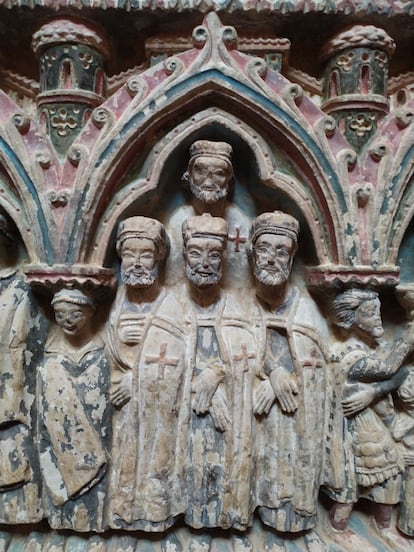
“Before these, the Templars settled on the Peninsula, as did the Knights of the Order of the Hospital and, to a lesser extent, the Teutonic Order,” explains De Ayala, one of the experts who participated in a course on the keys to Romanesque art this last weekend in July, entitled Art and Military: The Legacy of the Military Orders in Spain (12th-13th Centuries) , held in Aguilar de Campoo (Palencia) and organized by the Santa María la Real Foundation, which invited this newspaper. These courses, directed by the art historian Pedro Luis Huerta Huerta, are now in their 26th year and bring together students in two sessions each year.
“The Templars were very present in Aragon and Portugal, and the Order of the Hospital or of Saint John was present in Castile and León. After an initial period when they arrived, they soon began to be supplied with Spanish knights,” says De Ayala. An important difference between the orders on the Peninsula and those abroad “is that they were controlled by kings, not the Pope, which caused friction with the Pope,” adds this author of more than 200 articles on military orders. These religious militias were made up of men, mainly the so-called “freires caballeros,” who participated in numerous battles on the Peninsula. In some they lost resoundingly, such as Alarcos (1195), and in others they won, such as Las Navas de Tolosa (1212) and the decisive Battle of Salado (1340).
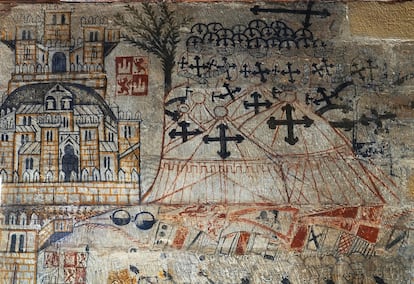
“These knights had to be at least hidalgos, members of the lower nobility, and were friars, therefore, leading an active life in society, not a contemplative one, like monks.” They had to be at least 17 years old. “When they entered, they were given a piece of bread, clothing, a horse, and weapons. At first, they were guided by the religious ideal—giving their lives for others—but over time, other ideals, such as fame, became evident.” Its members were bound by vows of obedience, chastity, and individual poverty, although these last two “were relaxed over time.” They also prayed. Professor De Ayala points out that it is documented that the knights of the Order of Calatrava “had to pray 267 Our Fathers a day.”
There were punishments for the unruly. In the Order of Montesa (Valencia), it was ordered that if a knight wounded another, "he would be locked in shackles until the master [who commanded the order] had mercy on him." Lack of humility was punished by "eating on the ground and being unable to scare away any dogs, cats, or birds that approached them." Meanwhile, expulsion or life imprisonment was awarded to those who fell into "continuous fornication, sodomy, concubinage, or betrayal on the battlefield."
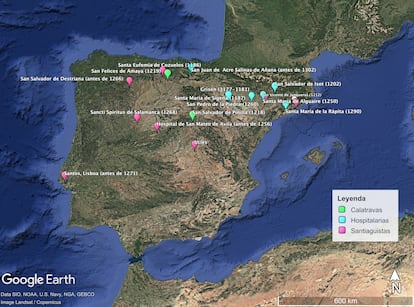
Despite this difficult reality, numerous myths were created about the orders. "The Templars take the cake; they've been mistreated by commercial literature because it was said to be an esoteric order." For De Ayala, the worst example is Dan Brown 's novels ("everything is invented"). "The problem with the Templars was their trial, which ended with their dissolution in 1312. They were accused of unproven accusations, such as idolatry and sodomy. In reality, the King of France wanted to do away with them." In Spain, it was the Catholic Monarchs who decapitated the orders to place them under their control.
There weren't just male military orders. Medieval History PhD María Ferrer-Vidal discussed those formed by women, the so-called freilas. "There were around 30 such convents in Europe—with around 200 women in total. Half of these centers were on the Peninsula because we had our own crusade here." Unfortunately, few material remains of these constructions remain.
"The role of the nuns was to pray so that their prayers would help the knights triumph in their battles. Imagine these women praying the same prayers to heaven at the same time in all those monasteries," she adds. Those of the Order of Santiago recited at least 90 Our Fathers a day.
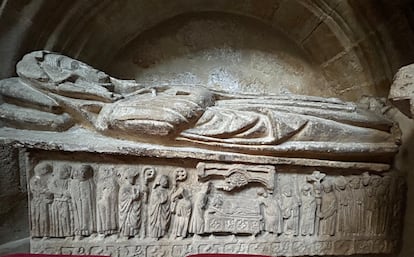
Economically, they were important because "by being in the rearguard, they accumulated territories that didn't require defense and could be used, for example, for transhumance." Ferrer-Vidal explains that for these women, joining these monasteries "gave them prestige, although many were there because they were widows of friars." She specifically studied the monastery of Santa Eufemia de Cozuelos (Palencia), visited during the course, of which only the church remains. It was the first female monastery of the Order of Santiago in Spain.
The nuns “wore simple fabric in monastic colors (white, black, brown, etc.) and had the emblem of their order embroidered on it.” As for their appearance, they had to keep “their hair short and hidden, and makeup and eyebrow plucking were prohibited.”
Javier Martínez de Aguirre , professor of Art History at the Complutense University of Madrid, spoke about the churches that were built in these special monasteries. He wondered who was behind these religious complexes, both in terms of financing them and in deciding how they would be built and their iconography. A significant part of the responsible parties were women. He cited the striking case of the three Ramírez sisters, who at the end of the 12th century each ordered the construction of a hospital with a church, which they then handed over to the orders in towns in Navarre and La Rioja.
Martínez de Aguirre focused on the kingdoms of Castile, León, and Navarre, and on the orders of the Holy Land (the Temple, the Hospitallers, and the Holy Sepulchre), explaining that "most of the buildings they erected had limited architectural ambition." However, he highlighted some examples, such as the Church of Vera Cruz in Segovia; the Monastery of San Juan de Duero in Soria, with its well-known cloister, "evoking the Holy Sepulchre in Jerusalem"; or the Church of La Magdalena in Zamora, "due to its size and ornamentation." These were exceptional sites because they were intended as "privileged burial grounds for women of that class."
But if there's one structure associated with the military orders, it's castles. David Gallego Valle , a history professor at the University of Castilla-La Mancha, is working on excavations of these religious institutions, especially their fortresses, of which, he said, there were two types: "Convent castles, which had their own church and refectory..." and "Command castles," which, in addition to the above, "administered large territories." "They were more stately and had warehouses."
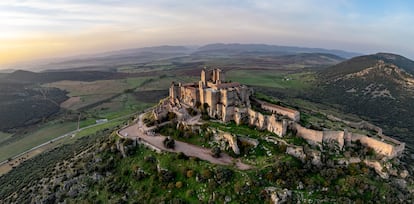
Most of these castles were located "in Aragon and La Mancha, although there were also some in southern Extremadura and northern Huelva." Surprisingly, it was common for the military orders not to build their own castles, but rather to take advantage of the fortresses conquered from the Muslims, which were of considerable size. "When the Christians took these buildings, they quickly built the keep, the church, and any other necessary elements inside." Many Mudejar builders participated in these projects. "The conquered lands were populated by Muslims, and the orders were interested in protecting those who were skilled in certain trades, such as the builders."
Contrary to what one might think when looking at them dominating the horizon, "a lot of botched jobs were involved in building castles," Gallego adds. "They were done very quickly because the position they had won had to be defended. They could take six or seven years to build, projects that involved women and children. For many people, seeing a castle built must have been the event of their lives, with 200 people working at once."
Within the perimeter of the castle were churches, naturally fortified, called castrales, as discussed by José Arturo Salgado , a doctor in Art History and professor at the University of Castilla-La Mancha. "Their walls were thick and often had a crypt, as a place of remembrance for the deceased." An exceptional case is the castle of La Estrella, in Montiel (Ciudad Real), belonging to the Order of Santiago, which had two churches within its grounds.
Professor Francesca Español Bertran , from the University of Barcelona, studied the activities of the military orders in the Crown of Aragon, where some churches were built "with a formal purpose," reminiscent of the Basilica of the Holy Sepulchre in Jerusalem due to their circular layout, although these were few and far between. She also referred to the "colossal" monastery of Sijena, founded in 1187, whose promoter was also a woman, Queen Sancha of Aragon.
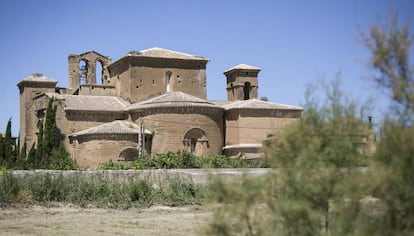
Finally, Julio Vázquez Castro , from the University of Santiago de Compostela, went to the other end of the Iberian Peninsula to discuss the Romanesque legacy of the orders in Galicia, a territory far removed from the struggle against the Muslims. "However, the orders came to possess 20% of Galician territory, always in rural areas." These militias served as a retreat for veterans. Vázquez highlighted the work of the Order of Saint John in Portomarín (Lugo), which they transformed "into a thriving town." There is the Church of San Nicolás, a fortified building notable for its height (16 meters) and the decoration of its capitals.
Professor Vázquez pointed out that these orders were not present in the lands of the Archbishopric of Santiago (the Order of Santiago was founded in Cáceres) because the ecclesiastical authorities opposed sharing income and land with knights it didn't need. However, as a twist of fate, over the centuries, "the Order of Santiago spread its well-known insignia throughout Spain, Europe, and America," the famous red "sword cross." Today, it is the logo that appears on the coat of arms of the city of Compostela, on its football team, and printed on any souvenir purchased there: a T-shirt, a keychain, a pilgrim's shell, and, of course, on the Santiago cake.
EL PAÍS





